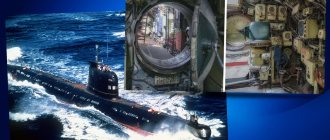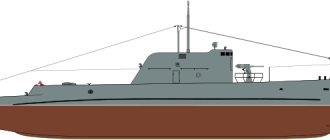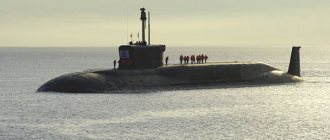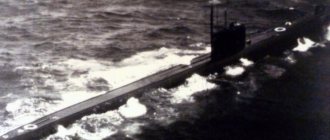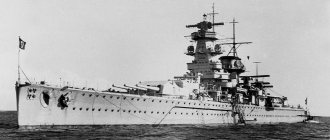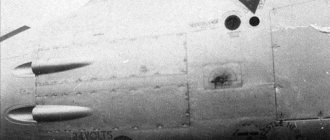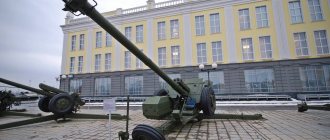The death of the nuclear submarine K-278 is close to the Chernobyl accident. A little time separates these events. And in terms of contamination with radioactive waste, they are also similar. Everything has long been known and sorted out, where, when and for what reason he died, but, nevertheless, we continue to be tormented by the question of some understatement. What happened in the cold waters of the Norwegian Sea? An accident, the consequences of crew incompetence or a situation caused by the influence of external factors. Much is known about that accident today, but practically nothing is known about its origins.
Monuments and memorial stands in memory of her have been installed throughout Russia: a monument in Severodvinsk, on the museum-submarine B-396 “Novosibirsk Komsomolets” there is an exhibition dedicated to the feat of sailors from the nuclear submarine K-278. They remember this in the city of Obninsk. This tragedy is mentioned in many books, including “the yellow submarine of the Komsomol member of Mordovia.”
"Gold fish"
A quarter of a century ago, one of the largest disasters in the history of the Russian submarine fleet occurred - on April 7, 1989, the nuclear submarine K-278 Komsomolets perished in the Norwegian Sea.
And even after 25 years, debate continues about the causes and culprits of that terrible tragedy. The submarine "Komsomolets" was unique, the only representative of the "685" project "Plavnik".
Article on the topic Submariner with the soul of a corsair. The true story of Alexander Marinesko
Back in 1966, the command of the USSR Navy set the designers the task of creating an experimental submarine with an increased diving depth.
The design of the unique nuclear submarine took eight years. To solve this problem, the designers used titanium to create a lightweight and durable body.
The laying of the boat at the enterprise in Severodvinsk took place in 1978, and K-278 was launched in 1983.
Due to the use of ultra-expensive titanium, as well as the length of time it took to design and build, the boat was nicknamed the “goldfish” in the navy.
But the K-278 was truly a unique ship. It could operate at depths where it was not detected by any enemy surveillance means and was inaccessible to any weapon with a conventional explosive. The nuclear submarine was armed with torpedoes and Granat cruise missiles. The weapon system allowed the K-278 to attack enemy ships and submarines from the depths of the ocean in a submerged position, remaining out of reach of them.
Armament
The missile and torpedo armament was located in compartment 1. It included 6 torpedo tubes with a caliber of 533 mm. The control is automated, the control type is combined, pneumohydraulic.
The autonomous stock of weapons was 22 units, the standard kit included:
- 2 cruise missiles launched from the S-10 “Granat” TA;
- 8 VA-111 Shkval missile torpedoes;
- 12 SAET-60M torpedoes.
Hydroacoustic weapons corresponded to the assigned tasks. An attempt to install more advanced systems in the mid-80s was unsuccessful due to a lack of internal space.
Thus, the proposed replacement of the Medveditsa-103 navigation complex with the Symphony-085 system was rejected due to the impossibility of releasing 30 m3 of volume. Apparently for this reason, the characteristics of the Symphony were considered redundant for a multi-purpose submarine, which was the K-278.
The same story happened with hydroacoustics and communications complexes; installation of modernized systems required free space, but there was none.
Failed Hero
Since 1984, K-278, included in the Northern Fleet, has been operated as an experimental submarine and a base for experiments in the field of ultra-deep diving.
It was assumed that the operation of the K-278 would allow one to gain experience to create a whole series of the latest next-generation submarines.
On August 4, 1985, K-278, under the command of Captain 1st Rank Yuri Zelensky, set an absolute world record for diving depth - 1027 meters. When surfacing at a depth of 800 meters, successful shots were fired from the torpedo tubes.
These tests showed that the Soviet Union received a submarine that has no analogues in the world. Captain Zelensky was nominated for the title of Hero of the Soviet Union, but the award was not approved.
At the end of 1986 - beginning of 1987, K-278, under the command of Yuri Zelensky, made its first autonomous combat campaign. In the summer of 1987, the boat changed its status from “experienced” to “combat”. In August – October 1987, the boat successfully completed the second “autonomy”. Under the command of Captain Zelensky, she received the very prestigious title of “excellent ship” in the navy.
Submarine "Komsomolets", January 1, 1986. Photo: Public Domain
Path to the pier
I come from the village of Gnivan, Vinnytsia region. There he worked as a milling operator at a factory in Gnivan, and there he enrolled in the scuba diving section. That's why they called me up for the navy. He served as a conscript in the North and remained there. And after the wedding he left for Kronstadt.
That’s when I got to Komsomolets.
Initially, it had a different name - “Fin”. But our political officer believed that the boat should be named. And they decided: since our crew is young, all Komsomol members, then let it be “Komsomolets”.
A third of the crew were from Ukraine. Commander Evgeniy Vanin is from Kiev, three guys are my fellow countrymen from the Vinnitsa region. To say that we were all friends is to say nothing. Even on land they often gathered together.
Fire in the depths
In January 1989, the submarine K-278 was given the name “Komsomolets”. A month later, K-278 set off on its third autonomous voyage, this time with a replacement crew, led by 1st Rank Captain Evgeniy Vanin.
Since the first voyage with a new crew is an extremely important event, representatives of the naval command in the person of the deputy commander of the submarine division and the head of the political department were also on board.
The autonomous campaign was successful until the return home, when it seemed that nothing extraordinary could happen.
Article on the topic
The captain's son: the Kursk submarine died 10 years ago
On April 7, 1989 at 11:03, while the Komsomolets was sailing at a depth of 380 meters at a speed of 8 knots, a powerful fire broke out in the 7th compartment of the boat for an unknown reason. The main version is considered to be an electrical equipment fire.
The fire quickly engulfed the entire 7th compartment and claimed the life of the sailor on watch Nodari Bukhnikashvili. When the fire was signaled to the central console, an attempt was made to use the boat's volumetric chemical fire extinguishing system (VOC), but this did not yield any results.
The temperature in the 7th compartment reached 1000 degrees, the fire penetrated into the 6th compartment, where midshipman Vladimir Kolotilin died.
By this time, an emergency alarm was announced on the boat, and Komsomolets began to ascend. At a depth of 150 meters, due to damage caused by the fire, she lost speed, and further ascent occurred due to the purging of the main ballast tanks. At 11:16, 13 minutes after the fire started, the boat reached the surface.
When later the search for the culprits begins and the Komsomolets crew begins to be accused of incompetence, the same deputy division commander who was on the boat, Captain 1st Rank Kolyada, will notice that if the crew were incompetent, the boat would not have risen to the surface.
Reproduction of the drawing “Norwegian Sea. Nuclear boat." Photo: RIA Novosti / Sergey Kompaniychenko
1976 March 16
Included in the lists of Navy ships as KrPL;
1976
K-278 was formed ;
1978 April 22
Laid down on the slipway of workshop No. 42 of the Sevmashpredpriyatie PA in Severodvinsk as a CRPL;
1978 July 25
Reclassified as a large submarine;
1983 May 30
Solemnly led out of the workshop;
1983 June 3
Launched;
1983 July - August
Mooring tests were carried out;
1983 August
The Naval flag was solemnly raised. Start of sea trials;
1983 December 28
The acceptance certificate was signed and put into operation;
1984 January 18
Included in the 6th DiPL of the 1st FPL KSF based at Malaya Lopatkina Bay;
1984 May
The reserve 604th crew of the nuclear submarine
K-278 ;
1984 June - 1985 November
The 604th crew underwent training at the Navy training center in Sosnovy Bor, Leningrad Region;
1984 December 14
She arrived at her permanent base; by this time the ship had sailed for 107 days, including about two months of sailing without civilian specialists on board. In accordance with the joint decision of the Navy and the Ministry of Shipbuilding Industry, the leadership of the trial operation was entrusted to the chairman of the commission - the commander of the 1st submarine flotilla - and was carried out according to a special program developed by the Main Command of the Navy and the Ministry of Shipbuilding Industry;
1985 June 29
The crew passed the course tasks, were included in the first-line ships of constant combat readiness and began preparations for deep-sea diving;
1985 July
In Zapadnaya Litsa Bay, undocking tests of the pop-up chamber were carried out;
1985 July 31 - August 7
Deep sea testing. On July 31, she entered the Norwegian Sea to conduct deep-sea tests (commander - cap. 1st R. Zelensky Yu.A., senior on board - commander of the 1st FPL V.A. Chernov E.D.). On August 4, I completed the deep-sea diving program. On board was the Chief Designer of the project, Yu.N. Kormilitsin, the technical director of the dive, the first deputy chief designer, D.A. Romanov, the responsible delivery person, V.M. Chuvakin, and the delivery mechanic, L.P. Leonov. At 12.43, the submarine sank to a depth of 1000 meters and remained there for 51 minutes, reaching a maximum depth of 1027 meters. When surfacing at 800 meters, she fired blanks at the torpedo tubes. On August 7, she returned to her home base; the submarine was met at the pier by the commander of the Red Banner Northern Fleet, Admiral I.M. Kapitanets;
1985 August - November
Inspection of mechanisms at PA “Sevmashpredpriyatie” in Severodvinsk;
1985 November
The reserve 604th crew arrived at its permanent location in Malaya Lopatkina Bay (Murmansk-150);
1985 December
A docking operation was performed at Shipyard-10 in Polyarny to repair the log stock;
1985 December 30
Removed from the dock and moved from Pala Bay to its permanent base in Lopatkina Bay;
1986
During the period of experimental tactical exercises, she tested an emergency gas generator system in the Norwegian Sea by ascent from a working depth of 800 meters;
1986 November 30 - 1987 February 28
Completed the tasks of an autonomous BS (commander - Cap. 1st Rank. Zelensky Yu.A., Senior - ZKD Capt. 1st Rank. Bogatyrev A.S.);
1987 June
Trial operation has been completed and put into operation for its intended purpose;
1987 August - October
Completed the tasks of the autonomous BS (commander - Cap. 1st R. Zelensky Yu.A). During the period of fulfilling the tasks of combat service, on September 25, she made a short visit to the base for transfer to the shore of IGAG-1, Art.
1988
The ship received the title "excellent";
1989 January 31
Received the honorary name
"Komsomolets" ;
1989 February 28
Entered combat service with 604 crew on board (commander - Capt. 1st Rank Vanin E.A.);
1989 April 7
She died while returning from combat service in the Norwegian Sea. The submarine was sailing at a depth of 380 meters at a speed of 8 knots, when at about 11.00 a fire broke out in the 7th compartment, the true cause of which remained unknown. At 11.12 an emergency alarm was announced on the boat, the boat began to float to a depth of 50 meters. For a number of reasons, it was not possible to extinguish the fire with the supply of LOX; the fire spread, as a result of which power electrical systems entered the fire zone; due to their damage at a depth of 150 meters, the emergency protection of the steam turbine unit was activated and the submarine lost speed. For further ascent, a command was given to clear out the group from the Central City Hospital, which largely served as the climax of the tragedy. Objective data suggests that during the execution of this command, a rupture occurred in the high pressure pipeline of Central City Hospital No. 10, located in the 7th compartment, as a result of which compressed air began to flow into the compartment under high pressure, which led to the development of a local fire into a volumetric one. Due to a sharp increase in pressure, air mixed with combustion products began to flow into the oil drain tank of the main machine, located in the adjacent 6th compartment; the excess pressure forced the oil “in reverse” into the compartment and sprayed it over the equipment. When the boat floated to the surface at 11.16, two compartments were already burning - the 6th and 7th, smoke erupted in the 2nd, 3rd and 5th compartments, at about the same time the control panel caught fire in the 3rd compartment and a flash of flammable gases occurred in the 5th. Already on the surface, the emergency protection of the nuclear reactor was activated, the main electrical circuits were turned off, and the power was transferred to the battery. The command was given to start the emergency diesel generator, which the crew carried out for more than two hours. At 11:37 a.m. the emergency signal was transmitted for the first time. However, due to the destruction of the hydraulic systems at this moment, the retractable devices began to lower under their own weight, perhaps this is the reason for the unreliability of the transmission of the emergency signal - on the shore it was received and deciphered only after 8 times, at 12 hours 19 minutes. Meanwhile, through the destroyed pipeline, hot air from compartment 7 enters the main ballast tank No. 10 on the starboard side, blowing it through, which forms a list to the left side. Without finding out the reason for the formation of the list, they try to level it by blowing through the opposite tanks, which leads to the entry of a fresh portion of air under pressure into the burning compartments. At this point, the personnel are included in hose breathing apparatus, into the system of which combustion products enter - the personnel begin to fail as a result of poisoning, and emergency parties are organized to remove victims from the compartments. The command was given belatedly to switch to IDA, but the first victims had already appeared in the crew. At 12.39, a patrol Il-38 flies to the scene of the accident, and at 13:20 the Northern Fleet command transmits the coordinates of the boat to the Alexey Khlobystov floating base, which goes to the site of the accident. At 14.40 visual contact was made with the Il-38 aircraft. All this time, attempts to eliminate the roll and carry out reconnaissance of the emergency compartments continued on the boat; meanwhile, water began to flow into the durable hull of the 7th compartment, the roll began to move to the starboard side, and the trim aft increased to 2 degrees. The boat has run out of LOX refrigerant and high pressure air. By 16.30 the situation began to rapidly escalate and at 16.40 the order was given to the ship to prepare for the evacuation of the boat, prepare the emergency equipment, and leave the compartments. The personnel began to hand over life rafts, but only one of them was able to be launched. At 17.08, the boat with a stern trim of up to 80 degrees quickly sank at a depth of 1858 meters at a point with coordinates 73°43'17 N. 13°15'51 E 23 crew members drowned along with the ship in the flooding area. 59 people ended up in the water, five, including the boat commander, remained in the VSK, of which only one person survived after the camera surfaced, and the camera sank. A total of 42 submariners died, the bodies of 16 dead and the survivors were lifted aboard the Alexey Khlobystov fishing base and the Oma fishing vessel. Further assessment of the causes of the disaster in various sources varies significantly - the leadership of the Navy blamed the designers and shipbuilders for the imperfections of the boat, the latter, in turn, stated the inept and sometimes even illiterate actions of the crew. However, it is very difficult to judge the correctness or error of the actions of a crew caught in an extreme situation. 05/12/1989 all crew members were awarded the Order of the Red Banner;
1989 May 17 - 26
The first expedition of the research vessel of the Academy of Sciences “Akademik Mstislav Keldysh” with two deep-sea vehicles
“Mir-1” and “Mir-2” on board to the site of the sinking of the nuclear submarine. On April 27, 1989, the R/V Akademik Mstislav Keldysh interrupted work in the Atlantic and entered the Norwegian Sea. The crews were tasked with: finding out the causes of the fire in the aft compartment, assessing the degree of destruction of the light and durable hulls, determining the speed and direction of the current of the sunken boat, measuring the leakage of radionuclides from the reactor, their settling in the ground and dissolution in water, checking the depth of corrosion of the shell, condition of plutonium warheads. The sources of radiation hazard on the nuclear submarine were a nuclear reactor cooled with pressurized water and two nuclear torpedo missiles containing about 6 kg of plutonium. The sunken submarine was found using a 360-degree radar installed on a towed vehicle of the Institute of Experimental Underwater Technologies of the Far Eastern Scientific Center of the Academy of Sciences. The towing was carried out by the research vessel Perseus. In addition to the submarine, located a mile from the place where it went under water, two more small targets were discovered. In the search area, 5 bottom transponder beacons were lowered from the research vessel Akademik Mstislav Keldysh. Mir-1 went under water (I.E. Mikhaltsev, A.M. Sagalevich and D.V. Vasiliev). An 11-hour search using a 360-degree radar, with very poor visibility, did not give a positive result. A subsequent comparison of the definitions of the navigation systems of “Perseus” and “Academician Mstislav Keldysh” gave a discrepancy of 600 m. Adjusting the targets on the map helped the crew of “Mir-2” (E.S. Chernyaev, N.L. Shashkov, M.V. Falin) get out on the boat pretty quickly. The pilot's sensor showed a depth of 1690 m. The boat was lying on a slope with a slope of 0.5°. Judging by the type of destruction of the light hull and the profile of the soil, the boat first hit the ground with its bow, and then the tail unit sank to the bottom. Five meters from the bow, a two-meter shaft was formed, with small ditches along the sides. The boat lay with a trim of 2° and a list of 0.5° to starboard, heading 9°. The hull of the boat was buried an average of 2 m into soft soil. Visible damage was in the bow. 700 m from the boat, the hydronauts discovered a rescue chamber - the second target. The third target was identified as a failed life raft. The first crew on Mir-1 on the third dive practically repeated the program of the second dive, although there was an incident.
Impacts on the hull of the boat during a very strong bottom current disabled the main engine. The measured background radiation in the immediate vicinity of the boat and on the sea surface did not exceed natural levels and amounted to 20 microroentgens per hour; 1989 December 1
The 604th nuclear submarine crew was disbanded;
1990 June 6
Expelled from the Navy. The main crew was disbanded;
1991 August - September
The second expedition of the research vessel of the Academy of Sciences “Akademik Mstislav Keldysh” with two deep-sea vehicles
“Mir-1” and “Mir-2” on board to the site of the sinking of the nuclear submarine.
The devices made six dives. The expedition used the towed apparatus of the Institute of Oceanology “Sound” with a 360-degree radar. With its help, the coordinates of the location of the nuclear submarine and VSK were clarified. External inspection, video recordings and photographs made it possible to get an idea of the condition of the boat. The light hull had virtually no damage in the middle and rear parts. In the area of the 7th compartment on the starboard side, the metal of the light hull was open, and the rubber coating that had peeled off during the fire was missing. The aft below-deck television camera was also not in place. The breakwater shields of six torpedo tubes are slightly open. The robust hull was badly damaged in the area from the bow to the wheelhouse. Destruction was observed on the starboard side in the lower part of the bow near the hydroacoustic antenna fairing and in the upper part in the wheelhouse area; near the emergency buoy; and the most significant - along the entire perimeter of the durable hull in the area where the horizontal rudders and their drives are located. As a result of subsequent analysis of the picture of the destruction of the pressure hull, experts concluded that the explosion that occurred a few moments before the separation of the VSK was very powerful and comparable only to the explosion of a torpedo. The aft deck, stern stabilizers and propeller blades had no visible damage. In total, the expedition spent 14 days in the work area, of which 66 hours and 33 minutes were under water. 10 hours of video recording were filmed, about 100 photographs were taken, 32 water and soil samples were taken from the nuclear submarine hull; 1992
The third expedition of the research vessel of the Academy of Sciences “Akademik Mstislav Keldysh” with two deep-sea vehicles
“Mir-1” and “Mir-2” on board to the site of the sinking of the nuclear submarine.
The vehicles made six dives of deep-sea manned vehicles. As in the previous expedition, the devices were equipped with measuring instruments: a gamma spectrometer, radioactivity meters, as well as water and soil samplers. Sorbents were installed in various places on the boat to determine the concentration of radionuclides uranium-235 and plutonium-239. Buoy and bottom stations measured temperature and current speed at different horizons. It was clear that sea water contributed to the corrosion of the localizing shells of nuclear charges. Particles of plutonium corrosion products can escape from nuclear submarines, in particular from open torpedo tube covers. It was decided to prepare to explore various options for sealing the nose compartment on next year's expeditions; 1993 August
The fourth expedition of the research vessel of the Academy of Sciences “Akademik Mstislav Keldysh” with two deep-sea vehicles
“Mir-1” and “MirR-2” on board to the site of the sinking of the nuclear submarine. The devices tested various filling options for the bow during 16 expedition dives. The cost of work to completely preserve the boat with a hardening compound was estimated at $15 million. This work was planned to be carried out next year - 1994. One of the important underwater operations carried out by the crews of Mir-1 and Mir-2 was an attempt to lift a pop-up rescue chamber from the bottom. The research vessel Akademik Mstislav Keldysh and the Northern Fleet kill ship KIL-164 took part in the lifting. On August 26 - 27, the Mir-1 (commander - A.M. Sagalevich) and Mir-2 (commander - V.A. Nishcheta) devices were able to capture and secure the camera.
At 7.41 on August 27, the rise of the chamber began. At 12.30 the stern of the killer took off on a large wave to a height of about 4 m, went down sharply and rose again to the same height. At the moment of lifting the stern, the cable separated from the pulley roller by 15 cm. It folded into a knot and broke. The camera at that moment was at a depth of 190 m. In this situation, all that remained was to fix the coordinates of the camera’s departure: 73°43’25” N. sh.; 13°05'55"E; 1994
The fifth expedition of the research vessel of the Academy of Sciences “Akademik Mstislav Keldysh” with two deep-sea vehicles
“Mir-1” and “Mir-2” on board to the site of the sinking of the nuclear submarine. Using the coordinates of the loss of the VSK, the locator of the towed vehicle “Zvuk” detected the VSK, and then “Mir-2” went to the camera lying on the ground.
After examining it, it became clear that the device with the ring was still inside and was ready for a new rise of the VSK. During the expedition, the tasks of the first stages of sealing the bow compartment were completed. The first stage of sealing consisted of closing six open breakwater shields of torpedo tubes and openings in the bow of the nuclear submarine. For this purpose, Rubin Central Design Bureau manufactured 9 titanium plugs, 6 smaller plugs and snap brackets for attaching the plugs, specially designed for this operation. The submersibles delivered 7 large plugs with a diameter of 2 m, 3 plug-covers and 12 brackets for open breakwater shields. This difficult operation was carried out under conditions of strong current drift, when the apparatus had to be kept a few centimeters from the bow end of the nuclear submarine. Then 6 plugs were installed on the brackets, the 7th plug remained next to the boat on the ground as a spare. Three caps were used to cover the holes in the bow of the boat. The design of one of the torpedo tube plugs provided for the possibility of taking water samples from the boat. Head of the Main Directorate for Work on the Seas and Water Areas of the Ministry of Emergency Situations, Rear Admiral M.G. Tolokonnikov said following the expedition: “The experts came to the conclusion that it is best not to touch the boat. It may collapse during lifting”; 1995 summer
The sixth expedition of the research vessel of the Academy of Sciences “Akademik Mstislav Keldysh” with two deep-sea vehicles
“Mir-1” and “Mir-2” on board to the site of the sinking of the nuclear submarine. Continuation of work on sealing the nasal compartment. Observations and filming of the bow of the boat, carried out in 1994 using retractable devices with a lamp and a miniature color television camera, made it possible to determine the nature of the destruction inside the durable hull: the bow and stern of compartment 1 were littered with metal structures, the compartment bulkhead was destroyed, the left upper torpedo tube was also destroyed destroyed. The durable hull is actually broken in the area where the horizontal rudders are located. The underwater work phase was preceded by the engineering phase, when special truss drop-down diaphragms, multi-section folding patches made of durable reinforced material, roll-up patches, plugs, elastic bags and autonomous hydraulic stations for filling the bags with water were manufactured. The delivery of all this equipment, the dimensions of which were often commensurate with the dimensions of the devices themselves, was carried out by underwater vehicles in several stages. After this, complex “surgical” operations began. First of all, two truss diaphragms were installed into the hull fracture, and an “umbrella” diaphragm was opened in front of them. The blocked volume of the bow was filled with 19 elastic bags with a capacity of 3 m3 each. Hydraulic autonomous stations, powered by batteries and installed on the deck of the boat, pumped water into them. 4-5 section patches, secured with clamps to the deck rails, were deployed along the sides. They covered the holes and tightly covered the sides of the boat, as heavy loads were suspended from their lower sections. The rod device hatch and ventilation grilles were covered with titanium covers. More than 100 bags containing a chemical substance capable of destroying microorganisms that carry radionuclides out of the boat were placed inside the isolated volume. To select plutonium from the water, molecular sieves were placed in the bow. Measuring the flow speed inside the bow of the boat before and after installation showed that the flow speed decreased 10 times and amounted to 0.5 cm/s. It took 19 dives of the Mir-1 and Mir-2 to seal the bow of the boat.
At the same time, scientific observations and measurements were carried out. The results of these measurements indicate a stable situation in the reactor area. Data from measurements of the concentration of cesium-137 in the ventilation pipe of the reactor compartment allow us to conclude: the fuel elements have not begun to deteriorate; 1998 July
The seventh expedition of the research vessel of the Academy of Sciences “Akademik Mstislav Keldysh” with two deep-sea vehicles
“Mir-1” and “Mir-2” on board to the site of the sinking of the nuclear submarine. "Mir-2" (E.S. Chernyaev, I.V. Ponomarev, N.V. Pimenov) passed above the deck and then worked in the wheelhouse area. The hydronauts took samples of water along with microorganisms using a special suction device - a “slap gun”. Mir-2 then sank to the ground in the bow of the boat, where sediment samples were taken. The recording stations installed by the devices near the boat back in 1995 were not found; all that remained of them were neatly undocked anchors. Only the current meter was found and taken into the bunker. At this time, Mir-1 (A.M. Sagalevich, D.V. Voitov, K.K. Rodionov) entered the area of the reactor compartment, where the gamma spectrometer had been located since 1995. And here only the anchor and a piece of halyard remained from the device. The first impression was that the instruments were removed or cut with the help of other underwater vehicles, perhaps even uninhabited remote-controlled robots. An examination of the sealing elements in the bow of the boat, which suffered the greatest damage, showed that all structures, including titanium plugs, remained in place. But sea water and time did not spare the aluminum parts of the structures installed at the fault site. As a result of electrochemical reactions, they were destroyed. the K-278 and VSK nuclear submarines from the bottom of the Norwegian Sea
still remains open To resolve this issue, a balanced approach and careful calculations by specialists in lifting non-standard objects from great depths are needed. The cost of such an operation is estimated at hundreds of millions of dollars; 2007 March
A Russian expedition was conducted to inspect the sunken nuclear submarine;
2019 July
Scientists from Russia and Norway have discovered a hundred thousand times higher radiation level in the area of the sunken nuclear submarine. Expedition leader Hilda Elisa Heldal reported this to TV2. The research vessel GO Sars set sail from Tromsø to investigate the environmental situation and measure pollution levels. The expedition was attended by specialists from leading research institutions of the Russian Federal Service for Hydrometeorology and Environmental Monitoring, Roshydromet NPO Typhoon and the Norwegian Institute of Marine Research. They took samples from a vent located in close proximity to the reactor. Heldal noted that the data on radiation levels exceeding one hundred thousand times are preliminary. “We will look at the samples more carefully when we get home,” she said. The scientist emphasized that the radiation leak does not pose a threat to fishing in the area. However, its level turned out to be higher than that recorded by Russian scientists during the previous expedition in 2007. The researchers used the AEgir 6000 submersible, which can reach the wreckage of the boat and transmit images to the ship.
The fight for survivability
The situation on Komsomolets was very difficult - the 6th and 7th compartments were on fire, the 2nd, 3rd and 5th were filled with smoke. There are many burnt and poisoned people in the crew. The emergency protection activated, automatically blocking the boat's nuclear reactor, and Komsomolets switched to using batteries.
The first signal about the accident was sent at 11:37, but due to increasing problems at the headquarters, it was received only at 12:19. An Il-38 aircraft with rescue containers was sent to the scene of the accident.
The IL-38 cannot land on water, so in this situation it could only observe and guide ships coming to the rescue to the scene of the accident.
Article on the topic
The sea is an inheritance: in a family of submariners there are 22 awards for four
Navy helicopters and seaplanes could not reach the accident site, located 980 kilometers from the Soviet border.
In addition, the first messages from Captain Vanin were quite calm - the ship has surfaced, the crew is fighting for survivability.
The IL-38, under the command of pilot Gennady Petrogradsky, took up a position over the accident area at 14:20. By this time, the Alexey Khlobystov floating base was coming at full speed to help Komsomolets, which was supposed to arrive at the site by 18:00.
By three o'clock in the afternoon it seemed that the worst was over. Three Soviet planes were circling over the area, ships were racing at full speed to the scene of the accident, and the fire, although not extinguished, was localized. Help should have arrived soon.
Most of the crew were on the upper deck without life jackets. The people who got out of the smoke-filled compartments were confident that the Komsomolets was unsinkable and did not imagine that they would soon have to leave the ship.
Ahead of the rest of the planet... in terms of accident rates
Naval service is not an easy task, especially under water. Extremely complex technology and the ocean itself do not forgive mistakes. This applies equally to all fleets of any power. Accidents with submarines happen in the fleets of all countries. But here's what the statistics say. In the period from 1945 to 2022, 186 accidents of submarines belonging to 16 states were recorded. At the same time, 109 incidents (58%) occurred in the Soviet (now Russian) fleet. The Soviet Navy lost 17 submarines, including 7 nuclear ones, forever. It is difficult to classify such results as accidents. The sea is the same for everyone, which means that the subjective factor probably comes into play. It can manifest itself both in errors during the design and construction of ships, and during their operation. In the latter case, the cause of accidents is sometimes the insufficient level of training of submarine crews. Sailors who entered the fleet not by vocation, but by conscription, and who also have a low general educational level, are unable or do not have time to master the most complex equipment that they have to maintain. Added to this is the fact that material training is often replaced by political information or work outside the ship, such as cleaning base areas, etc. The officers on the ship have their own problems. Serious knowledge acquired at one time in schools, advanced courses and academies dissolves in a sea of bureaucratic writings, which does not leave time for studying continuously updated technology and training subordinates. But the safety of the ship and its crew directly depends on all this. Here is an example from the tragic history of the Komsomolets nuclear submarine. When, leaving a sinking ship, the sailors had to use life rafts, it turned out that none of them, including the officers, knew how to do this. Later, one of the surviving officers of this nuclear submarine answered the question of the commission investigating the causes of the disaster: “Have you been involved in dropping rafts in everyday life over the past 5 years?” - answered: “Never.” In the navy, we are busy writing papers, not practicing the fight for survivability. No one ever gave up the emergency rafts. Exit through the torpedo tube was also not practiced. We don’t know how to open aviation (air-dropped) rafts. I've never seen them." And, unfortunately, there are many such examples. Ship officers write to headquarters, who, in turn, also write. Above each headquarters, be it the headquarters of a brigade, division or flotilla of submarines, there is the next headquarters in the hierarchy, up to the General Headquarters of the Navy. Mountains of papers leave little time for things, of which there are many: you need to think about replenishing the fleet, developing a strategy, planning training and sometimes combat campaigns, resolving issues of arranging bases, their supplies and everyday life. It’s not just in the offices that staff members serve; they periodically go to the fleet, and sometimes go to sea. In cases of emergency, they have to find (or assign) the culprit. And this must be done according to the law and conscience. This is not easy and is not always successful. It happens when, while shielding the true culprits (sometimes themselves), they shift the blame onto those below them (worse of all, on the dead), or even simply write everything off as a fatal coincidence or irresistible forces of nature. Let's give an example. In 1983, the nuclear submarine K-429 underwent scheduled repairs at a shipyard located in Kamchatka and owned by the Navy. The headquarters of the unit unexpectedly decided to speed up the completion of the repairs and immediately send the nuclear submarine into autonomy, despite reports from its commander about the ship’s obvious technical unreadiness and the fact that most of the boat’s crew was on vacation. They did not listen to his arguments, suggesting that in case of disagreement, he would remove his shoulder straps and “party card on the table.” On June 24, K-429, with a crew hastily assembled from other ships, set out on a voyage and on the same day, during its first dive, sank at a depth of 39 m (the maximum depth of a nuclear submarine of this type is 300 m). It later turned out that the cause of the accident was an error by the factory electricians, which, coupled with the unpreparedness of the crew, cost the lives of 16 sailors. The court considered (rather, appointed) the ship's commander to be the culprit of the tragedy (despite his reports about the unpreparedness of the boat and heroic behavior in rescuing the crew from the sunken submarine), sentencing him to a long term of imprisonment.
The boat sank in a few minutes
At 16:35, the Il-38 crew noticed that the K-278 began to settle to the stern. As a result of a powerful fire, the tightness of the boat’s durable hull was broken, and the Komsomolets began to flood. It happened quickly.
Article on the topic
The last parade is coming. The nuclear submarine "Leninsky Komsomol" was scrapped
At 16:40, the boat commander gave the order to prepare for the evacuation of the crew, prepare a pop-up rescue chamber (PSC), and leave the compartments. The personnel began to hand over life rafts, but only one of them was able to be launched.
Seven minutes later, the conning tower was half submerged in water. At 17:00, the crew without personal life-saving equipment began to evacuate onto a life raft. A rescue container was dropped from the Il-38, but it malfunctioned and the sailors were unable to use it.
At 17:08, K-278 Komsomolets quickly went into depth. 61 people were caught in the icy waters of the Norwegian Sea. People who did not even have life jackets, were poisoned by carbon monoxide during the fire, burned, held on with all their strength.
Captain 3rd rank Anatoly Ispenkov remained inside the strong hull of the boat. The commander of the electrical division until the last ensured the operation of the diesel generator of the dying Komsomolets. He did not have time to get out of the sinking boat...
Description of the design of the Project 685 nuclear submarine
APKr 1st rank project "Plavnik" was planned to be used at depths of up to 1000 meters. This left its mark both on the design and on the materials. The nuclear submarine's hull had a classic design: a welded, durable hull in the form of an eight-meter cylinder. At both ends the cylinder ended in conical sections, the narrow part of which was closed by spherical bulkheads.
The tanks and main ballast lines were located inside a pressure hull, which subsequently played a role in the rapid death.
The hull was divided into 7 compartments with sealed bulkheads. In order of priority from the bow bulkhead:
- 1 compartment, torpedo;
- 2 compartment, residential. Entered the “rescue zone”;
- 3 compartment, central post. On the stern side there is a strong bulkhead, from above there is access to the deck through a rescue capsule;
- 4 compartment, reactor;
- 5 compartment, auxiliary mechanisms;
- 6 compartment, turbine;
- 7th compartment, aft.
There was no wheelhouse or torpedo-loading hatch, since it was decided that the hull could not be weakened. The torpedo tube exits, horizontal tail and scuppers had sliding covers.
Separately, it should be noted the inclusion in the life-saving equipment of the so-called “rescue zone”, in the form of two compartments fenced off from the rest by stronger bulkheads and the inclusion of an emergency deep-sea capsule in the composition of the means.
The system of pyrotechnic blowing of ballast tanks is also of interest, since classical air blowing at depths of over 600 meters worked extremely ineffectively.
Abyss Survivor
K-278 was equipped with a pop-up rescue chamber, which allows the entire crew of the boat to escape from the depths. At the moment when the Komsomolets sank, five people were in the VSK: the boat commander Evgeny Vanin, captain 3rd rank Yudin, midshipmen Slyusarenko, Chernikov and Krasnobaev.
Article on the topic
Leaving widows. The history of the most famous submarine of the USSR
Captain Vanin rushed inside the boat, hearing the voices of people in it. Those who remained on the surface barely had time to batten down the hatch behind it - only this left a chance for those remaining inside to escape with the help of a rescue chamber. Yudin, Slyusarenko, Chernikov and Krasnobaev, who were climbing the ladder at the time of flooding, were literally thrown down due to the fact that the sinking boat stood almost vertically. Midshipman Slyusarenko was the last to be dragged into the cell. Yudin and Chernikov desperately tried to close the bottom cover of the chamber, which weighed more than 250 kg. They managed to do this with incredible difficulty.
The chamber, filled with smoke, sank along with the boat to the bottom, which in this place was at a depth of more than one and a half kilometers. The divers tried to disconnect the camera from the boat.
Captain 3rd Rank Yudin suddenly shouted: “Everyone put on breathing apparatus!” Only Slyusarenko and Chernikov managed to do this - the rest, including Yudin himself, died.
Submariners died due to carbon monoxide, whose effect increases many times with increasing pressure.
The camera separated from the boat almost at the bottom when the Komsomolets hull was damaged under the pressure of the water column.
The escape capsule was thrown to the surface like a champagne cork. The top hatch cover, secured with one latch, was torn off, and Chernikov and Slyusarenko were thrown out with it. But the first died after hitting his head, and only Slyusarenko survived, ending up in the water. The rescue chamber was overwhelmed by waves, and after a few seconds it finally sank to the bottom.
Midshipman Slyusarenko was picked up by rescuers some time later. Viktor Fedorovich Slyusarenko is the only person in the world to survive from a submarine that sank at a depth of one and a half kilometers.
Last refuge
About 70 minutes passed from the moment the Komsomolets was scuttled until the mother ship "Alexei Khlobystov" arrived at the scene of the disaster. These minutes turned out to be fatal for most crew members. 16 people drowned, another 16 died from hypothermia, and their bodies were brought on board along with the remaining 30 sailors.
Three more died on board the mother ship, although at first glance their condition did not cause concern. Doctors later explained that being in cold water had already triggered irreversible changes in their bodies, and it was impossible to save them.
As a result, out of 69 crew members, 42 died and 27 survived. On May 12, 1989, the Presidium of the Supreme Soviet of the USSR issued a decree awarding all members of the Komsomolets crew - living and dead - with the Order of the Red Banner.
Funeral procession during the funeral of sailors of the Komsomolets submarine, 1989. Photo: RIA Novosti / V. Kuznetsov
The Komsomolets submarine has been resting at a depth of 1,650 meters at the bottom of the Norwegian Sea for a quarter of a century. From 1989 to 1998, seven expeditions were carried out using the Mir deep-sea submersibles, during which the condition of the boat was monitored, as well as work to ensure radiation safety. It was determined that the boat's reactor was securely shut down and it currently does not pose a threat to the environment.
In 1998, the investigation into the death of the Komsomolets submarine was suspended due to the “failure to identify the person to be charged as an accused” and the fact that “it is not possible to establish the true causes of the fire and flooding before lifting the submarine and inspecting it.” .

